A residential electrical permit is required for new residential service, new electrical equipment and/or fixtures, replacement of electrical equipment or fixtures, and electrical vehicle charging station circuits and outlets.
Mechanical, electrical and plumbing permits, commonly referred to as “trades permits” do not require plans. Trade permits can be obtained online after the associated building permit is issued.
Note: Some residential properties (example: apartment buildings and condos) are considered commercial per the building code and therefore require commercial building permits. To be considered residential, a project must consist of a detached one- or two-family dwelling or townhouse as defined by code.
ON THIS PAGE
This information is the most common for how to obtain the necessary approval for your project and is not representative of all the conditions you may encounter.
WHO SHOULD APPLY?
Property owners may obtain permits in their own name, however, it is strongly recommended a properly licensed contractor pull the permits as the responsible party so the county can better assist in gaining compliance for defective work.
PLAN AHEAD
Before submitting, ensure you are aware of all applicable regulations and conditions that could affect your project to avoid surprises during the review process. Some of those factors include:
- Zoning Information
- Design Codes and Standards
- Do I Need to Hire a Registered Design Professional (RDP)?
- Floodplains
- Resource Protection Areas (RPA)
- Grading/Site Plans
- Parking Tabulation
- Types of Soils and Problem Soils
- Researching Site Conditions
To get a detailed description about each regulation and condition, visit our Plan Ahead page.
HOW DO I SUBMIT MY RECORD?
PLUS Application
Apply for your residential electrical building record online in PLUS under the Building tab. If you are a first-time user, you must first register for an account.

Instructional Videos for PLUS
Helpful Instruction Guide:
Requirements
Depending on the scope of your project, one or more of the following may be required:
First Submission
- If your residential electrical service is rated over 600 amps, plans are required and must include the following:
- Plans must include a service riser diagram which provides the conduit/trough sizes, conductor sizes, overcurrent protection devise used with sizes and a ground detail.
- All design and installation requirements must be per the current National Electrical Code year cycle for the State of Virginia.
- Service rated at or below 800 amps may be designed by a Virginia Master Electrician or Virginia Class "A" electrical contractor.
- Virginia law requires that, where an architect/engineer seal is not present, the plans must be signed by the individual (not company) responsible for the design, including the person's occupation, address, and Virginia License Number.
- If your residential electrical service is rated over 800 amps, the below information must be included in your plans.
- A service riser diagram which provides the conduit/trough sizes, conductor sizes, overcurrent protection devise used with sizes and a ground detail and must be signed and sealed by a Registered Design Professional in the Commonwealth of Virginia.
- All design and installation requirements must be per the current National Electrical Code year cycle for the State of Virginia.
- Reference the parent building permit number if the proposed scope of work was shown on a previously approved set of Architectural/Structural Plans.
- If plans were previously approved under a residential new building (BLDR) or residential addition/alteration (ALTR) permit, plans do not need to be uploaded with this record.
- Architectural/Structural Drawings
- If work was not shown on a separately approved building permit (noted above), provide plans meeting the necessary minimum submission requirements.
- Fairfax Coversheet
- If work was not shown on a separately approved building permit (noted above), upload the Fairfax Coversheet document separately from the plan coversheet contained within your architectural/structural drawings.
- Permit Authorization
- Required if the applicant is not the owner and is not a licensed contractor.
- Property Ownership Affidavit
- Required if the owner information does not match current tax records, often when there is a new owner.
- License Exemption Affidavit
- Required if a licensed contractor is not listed on the application.
- Projects located in the towns of Clifton or Vienna require separate approvals from the respective towns.
- Approval documentation from the appropriate township must be uploaded to your PLUS record, via the Digital Plan Room, and named accordingly (e.g., Town of Vienna Approval).
Subsequent Submissions
If corrections are required, you will receive an email with links and instructions to make corrections and resubmit.
- “Issues” are comments from reviewers, which require an applicant response before resubmitting. Please respond to each “open” comment.
- Prior to responding to comments and uploading revised plans/documents, navigate to the “Fees” tab and pay any outstanding resubmission fees.
- Once complete, respond to all “open” issues, upload updated plans and/or documents, if needed, and complete your resubmission.
For further assistance, please refer to the below videos for step-by-step guidance on the resubmission process:
Helpful Videos:
 Upload Corrected Plans - YouTube
Upload Corrected Plans - YouTube
Helpful Instruction Guides:
What's Next?
To get a step-by-step guide on PLUS statuses and what they mean, see our What is My PLUS Status? Building Plans Infographic



